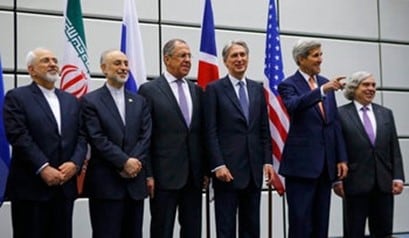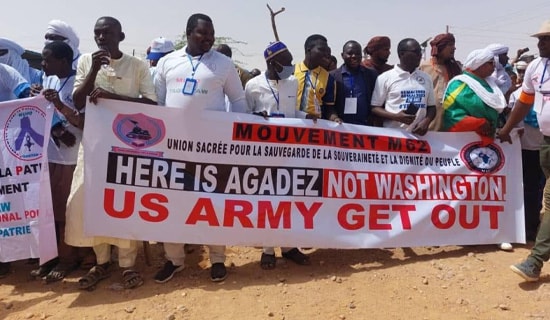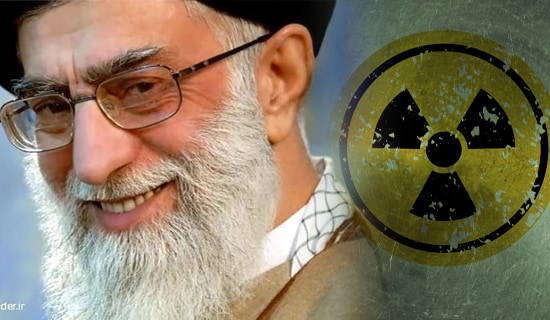
Representatives of Iran and world powers at the signing of the JCPOA nuclear agreement in Vienna, July 2015 (Source: Reuters)
The U.S. and European governments’ political sentiment regarding a return to their 2015 JCPOA nuclear deal with Iran seems to be trapped in the amber of that joyous hour in Vienna, in July of that year, when they and Iran had finally agreed on, and hailed, the terms of the deal. The current diplomatic quest to revive that agreement overshadows the snares that the Iranians so cleverly left in the text, which have been disregarded by the Western parties to it. Therefore, it is worth taking a look at reservations about a return to the JCPOA that we voiced in April 2021.[1]
In its negotiations with the world powers on the 2015 JCPOA nuclear deal, Iran had two goals. The first was to pave the way to recognition of Iran as a nuclear threshold state. This was achieved by means of a resolution in the U.N. Security Council ratifying the agreement, effectively establishing Iran's right to carry out the full enrichment cycle on its soil. The breakthrough to achieving this goal had come three years earlier, when the U.S. consented to this status for Iran in its 2012 letter to the Omani sultan.[2]
Iran's second goal was to leave gaps in the agreement wide enough for them to continue to develop nuclear weapons without being accused of violating the agreement. Iran achieved this goal in a series of talks, primarily with the U.S., in Geneva in 2013 and in Lausanne and Vienna in 2015. During these talks, Iranian nuclear scientist Mohsen Fakhrizadeh, Iran's military nuclear program chief (who was assassinated in November 2020), had, according to Iranian government spokesman Saeed Khatibzadeh, "stood behind the scenes and advised in the nuclear agreement."[3]
On July 14, 2015, the day the JCPOA negotiations were concluded in Vienna, U.S. President Barack Obama declared that the International Atomic Energy Agency (IAEA) would "have access where necessary, when necessary" to every aspect of Iran's nuclear project. This optimistic statement had no basis, either in the agreement or in its implementation. For example, the Voice of America announced on January 14, 2016 that "the U.S. confirmed [today] that Iran has poured concrete into the core of the Arak nuclear reactor, making it nearly impossible to produce weapons-grade plutonium at the facility."[4] But a year later, the director of the Atomic Energy Organization of Iran (AEOI), Ali Akbar Salehi, said in an interview that Iran had not poured concrete into the reactor itself but only into a few exterior pipes a few meters long and a few centimeters in diameter. He added that reactivating the Arak reactor would take a few months.
The main problem with the 2015 nuclear agreement is not the Iranians' deception, but rather its agreed-upon wording. Thus, according to the agreement, military facilities in Iran remain "out of bounds" for IAEA inspectors; according to Article 74 of the agreement's Annex 1, "requests for access [to Iranian facilities] pursuant to provisions of this JCPOA will be made... with due observance of the sovereign rights of Iran... [and] will not be aimed at interfering with Iranian military or other national security activities..."[5] This wording was sufficient for Iranian Foreign Minister Javad Zarif to announce on July 22, 2015 that such visits to Iranian nuclear facilities cross "red lines" and that in the talks, Iran had "completely succeeded in ensuring" that the agreement would not permit them.[6]
Additionally, Iranian Supreme Leader Ali Khamenei declared at that time: "[The foreigners] shouldn't be allowed at all to penetrate into the country's security and defensive boundaries under the pretext of supervision, and the country's military officials are not permitted at all to allow the foreigners to cross these boundaries or stop the country's defensive development under the pretext of supervision and inspection."[7]
The sincerity of these declarations was tested two years later, when, in August 2017, the U.S. demanded that the IAEA examine prohibited nuclear materials at military sites in Iran. A month later, Ali Akbar Velayati, advisor to Khamenei, said that Iran refused to allow this, and the next day Foreign Minister Zarif claimed that Article 74 of Annex 1 of the agreement stressed that visits to Iranian military facilities "cannot serve as a pretext for gathering information about Iran's secrets." There was one exception to this position: In order to allow it to conclude the political discussion on its nuclear activity that preceded the agreement, Iran allowed a visit to its military facility at Parchin. However, only IAEA director Yukiya Amano was allowed to enter – for a few minutes and without his cellphone. Furthermore, the required field samples were not collected by the inspectors, but instead were provided by the Iranians.
SUPPORT OUR WORK


Iran's nuclear sites. Source: IAEA
Additionally, the agreement does not allow challenge inspections at other suspect sites that are nonmilitary, and erected seven obstacles to such visits: In the first stage, intelligence evidence for the IAEA visit must be submitted to Iran. In the second, the IAEA must explain to Iran, in detail and in writing, all the relevant information, and Iran can then suggest its own way of verifying that there is no nuclear material at the site in question without any visit.
Furthermore, in the event of disagreement, the discussion about Iran's suggestion will be transferred from the experts, the IAEA, to the JCPOA's Joint Commission, which comprises all eight parties to the agreement including Iran. Thus, three weeks go by, when in the absence of Iran's agreement the issue can now be passed on for discussion to the foreign ministers of the countries party to the agreement for another two weeks – a period that can be extended by consensus. Therefore, even at civilian facilities where nuclear activity is suspected, the JCPOA actually does not allow challenge inspections "where necessary, when necessary."
It should be noted that in order to create an effective nuclear detonation, there is a need not only for fissile material, but also for the knowhow to detonate it symmetrically and simultaneously using a multi-point explosive detonation system. Therefore, in Vienna, the Iranians devoted special attention to Article 82 of Annex 1 of the JCPOA, which states: "Iran will not engage in the following activities which could contribute to the development of a nuclear explosive device... unless approved by the Joint Commission for nonnuclear purposes and subject to monitoring." Of course, Iran can learn much from "nonnuclear purposes" as well, but the fundamental problem in this Article is that this political Joint Commission has no inspection capability, while the IAEA, with its professional capabilities, has been intentionally excluded from this essential aspect.
Since 2015, Iran has never requested approval of its activity in this realm and in others like it, and when in 2017 the IAEA demanded oversight of Iran in accordance with this Article, Amano accepted the joint Iranian-Russian interpretation of the text – i.e. that the IAEA has no standing to enforce this article of the JPCOA because it is a problem for consideration by the Joint Commission. Thus, the Iranians took advantage of their rivals' enthusiasm, allowing themselves the very same progress towards a nuclear bomb that the agreement aimed to prevent.
The countries that seek to force Iran to obey the sloppy agreement that they signed should have learned of its flaws long ago, and should have realized that Iran has used it to lead them around by the nose.
With this understanding of his rivals, Supreme Leader Khamenei allowed himself to warn, in his February 22, 2021 speech to the Iranian Assembly of Experts: "The international Zionist clown keeps saying 'We will not allow Iran to obtain nuclear weapons'... If we wanted to obtain nuclear weapons, you would not have been able to stop us, nor would those who are bigger than you."[8]
* A. Savyon is Director of the MEMRI Iran Media Project; Yigal Carmon is President of MEMRI; Ze'ev B. Begin is a Senior Fellow at MEMRI.
[1] Haaretz (Israel), April 15, 2021.
[2] Tasnim (Iran), July 7, 2015.
[3] Tasnim (Iran), January 12, 2020.
[4] Voanews.com/a/iran-fills-nuclear-reactor-core-concrete-united-states-says/3146416.html, January 14, 2016.
[5] MEMRI Inquiry and Analysis No. 1325, Discussion Of Iranian Violations Of JCPOA Is Futile; The Inspection Procedure Designed By The Obama Administration Precludes Actual Inspection And Proof Of Violations, August 18, 2017.
[6] English.farsnews.com, July 25, 2015. See MEMRI Daily Brief No. 57, What Iran Is Permitted To Do Under The JCPOA, September 17, 2015.
[7] English.farsnews.com, July 25, 2015. See MEMRI Daily Brief No. 57, What Iran Is Permitted To Do Under The JCPOA, September 17, 2015.
[8] MEMRI TV Clip No. 8706 Iranian Supreme Leader Ayatollah Ali Khamenei: If We Wanted To Obtain Nuclear Weapons, Nobody Would Be Able To Stop Us, February 22, 2021.




